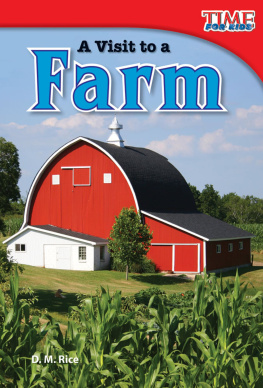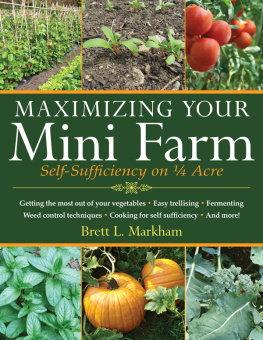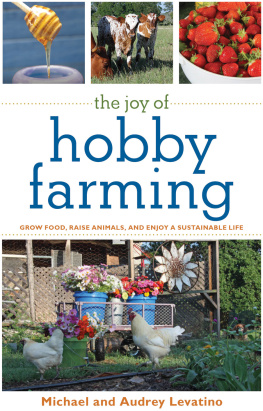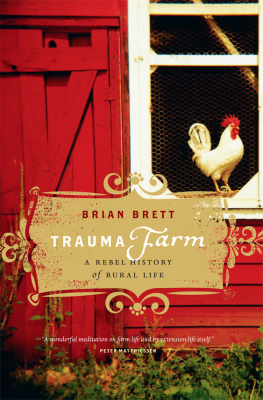As a child, my father was known to family and friends as Bob-the-White-Horse. He played for hours on end that he was the Percheron draft horse named Bob on my grandfather's farm. He hooked himself up to a crate with binder-twine harness and completed a variety of farm duties daily. This pattern of play set the stage for a life dedicated to farming and being in a position to pass down a tradition to his family. I dedicate this book to his memory and to all of the hard working farming men and women like him who have made American farming the most productive in the world.
A Century on the Farm
T he second edition of this book on collectible items related to farming and farming households in America includes photographs and illustrations in full color. Pricing information has also been updated when needed, but most pricing has not changed much in the past three years other than going up with general inflation and even faster in a few select areas, such as a larger increase in fine duck decoys and some other items. Tractor values have actually flattened out some in the past three years since the first edition due to economic issues in our nation and especially in the American farm community.
This book covers items of a collectible nature related to farming in North America from the period beginning shortly after the Civil War until approximately 1965. Many of our current farming collectibles were invented prior to 1900 and examples are still readily found for sale, with some of the items still in use on farms. These dates correspond to the beginning impact of the industrial revolution on farming in America and the manufacture of many items that have now today become collectibles and antiques of interest to many, not just farmers and those raised on the farm. Also, you never know where you may find an item of interest. In July of 2006, for instance, while buying a duck decoy collection, I also picked up a nice original wooden handle drill and bit for boring holes in barn post and beam construction.
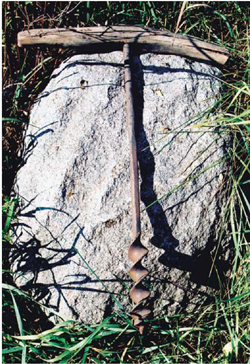
I found this nice antique wooden drill and bit for post and beam construction while buying a duck decoy collection in Grand Rapids, Mich., in July 2006, $75+.
The time period selected represents the evolution from a truly agrarian society to an urban society in America. Many people now find farm collectibles of interest partly due to the romantic ideal of an agrarian society. As a life-long farmer, I know that not all aspects of farming are as ideal as we like to think. However, I also know that this is an area of great interest to the general public and I hope this book is helpful in identifying and pricing farm related antiques and collectibles.
Not much has been written in this field, and nothing in the past 10 years. Only a handful of earlier works, now out of print, deal with this field and the field is so large that many books could be written about the area, basically covering each chapter in this book. But this is a beginning, a guidepost if you will. Or should I say a corner post.
This is not a book just about tractors! Tractors are of course included, but many fine guides exist on full-size tractors that are referred to in the text. I have included items related to tractors and implements as part of the book in the fields of advertising and toys and Chapter 12 gives a brief overview on collectible tractors from the classic era of tractor development, the 1930s-1960s. I was fortunate to have Tractor Supply Co. stores sell the first edition of this book and it found its home on the shelves amongst many fine books on tractors.
Why should you listen to me? I have been farming since shortly after birth. I was the Gold Star State Dairy Farmer for the Future Farmers Association in Michigan in 1965, one of 22 youths selected for their knowledge and ability in farming out of a pool of 22,000 at the time, and the only youth selected for dairy farming. I still farm. I raise draft horses and North Country Cheviot, Oxford and Scottish Blackface sheep with my wife, Wendy, and have raised and milked Jerseys, Ayrshires, Brown Swiss, Holsteins, Milking Shorthorns and even one Guernsey!
I have also spent many a Saturday the past 35 years attending the ever present farm auction to look for treasures needed for farming or collecting. I've amassed so many items over the years that I have had three fairly large farm auctions myself, one holding the record for buyer's numbers, at nearly 500 buyers, for some time.
Also, as an anthropologist, I spent years working with and writing about the Old Order Amish and living within their communities in Indiana and Michigan while studying their agricultural techniques and the energy efficiency of horse agriculture.
This familiarity with the older equipment used by the Amish simply added to my interest in farm antiques and collectibles.
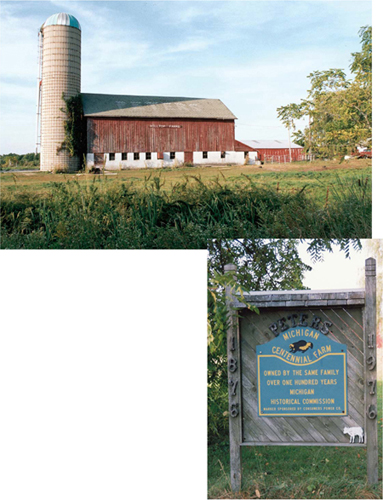
This is our dairy barn built by the Peters family in 1876 and still sound. The dairy cup and stanchions shown in Chapter 7, Page 136, are from this barn. The original Centennial Farm sign, at right, indicates the age of the farm. These signs are themselves collectible, as discussed in Chapter 3. The farm was in the Peters family from the time of a grant by the U.S. government in 1876 until they sold it to us in 2001. If it could only tell stories!

I'm still an active farmer and raise three different kinds of sheep, along with draft horses.
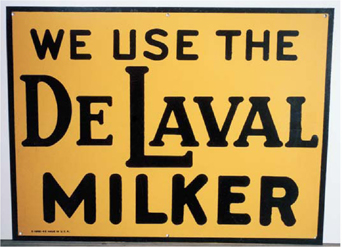
One of the lucky finds for us is this black and yellow DeLaval sign that is virtually new from old stock found in an old hardware store in Bay City, Mich., in the past 20 years. The store was a DeLaval dealer-ship and had a box of 12 of these signs still with the shipping paper attached new in the box,








